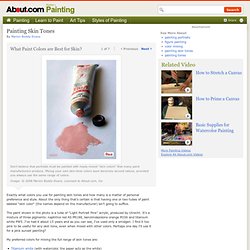

How to Create Realistic Flesh Tones: 7 steps. Edit Article Flesh tones 1Flesh tones 2 Edited by Liz Boston, Ben Rubenstein, Axiom, Flickety and 13 others Creating realistic flesh tones tends to become something every advanced people-focused artist gains an avid interest in.

Over time, you'll develop your own mixes that work for you but a little help in understanding the right color mixing techniques is a good place to begin. Ad Steps Method 1 of 2: Flesh tones 1 1Use several colors of paint. 8Finished. How to Paint Skin Tones. Exactly what colors you use for painting skin tones and how many is a matter of personal preference and style.

About the only thing that's certain is that having one or two tubes of paint labeled "skin color" (the names depend on the manufacturer) isn't going to suffice. The paint shown in the photo is a tube of "Light Portrait Pink" acrylic, produced by Utrecht. It's a mixture of three pigments: naphthol red AS PR188, benzimdazolone orange PO36 and titanium white PW5. Paint Colors for Mixing Skin Tones.
Which paint colors or pigments are your favorites when it comes to mixing up skin tones?

Do you have a standard "recipe" or set of colors you use? Skin color mixture A good mixture is Burnt Sienna, Chromium Green Oxide and White. —Guest Peter Feldman Individual Coloring There is no such thing as a uniform skin tone. —Guest Ana Wieder-Blank Ever Used This Mix? I use: Cadmium Yellow + Dioxizine Violet (Purple) + White. —Guest Khabran Flesh Tones Thanks for various suggestions for making flesh/skin tones. —Guest Vinod Naik. Skin Tone Painting Tips. Add your own skin-tone-mixing tips here...

I'm not a portrait artist, but one of the projects I set in my Painting I class is to paint a portrait from a photograph. I teach students a very-simple-to-remember "recipe" using approximately seven parts white (I prefer flake white because it's warmer), one part yellow ochre, and a pinch of cadmium red light (about the equivalent to two tenths of one part). For shadows I encourage them to experiment, but using more yellow ochre and cadmium red will gradually darken the skin tones.
For more drastic and darker shadows I suggest adding burnt sienna and/or burnt umber and even a little alizarin crimson. For darker skin tones I usually suggest using burnt and/or raw sienna (depending on how "red" the color of the skin might be) and green (the green usually suggested is viridian, but, again, I encourage experimenting until they find something they like). Here is my best 'recipe' for flesh tone colors: 1. Tip from: Monique Simoneau. Oil painting for beginners. Painting Techniques: Lessons, Tutorials, and Resources.
General Topics | Watercolor & Gouache | Oil | Acrylic | Other | Matting & Framing | Art Supplies General Topics: Art, Design, and Visual Thinking -- This art course provides an excellent overview of the visual language of art and teaches students how to analyze design, thus giving a better understanding of what it takes to create a successful work of art.

Learn about the design elements and principles of art, the various media employed in creating art, the history of art, and its most popular movements. Essential Painting How To's -- About.com provides step-by-step information and essential techniques for beginner painters. Free Art Lessons -- Free online art demonstrations in a variety of media. Design: Instructional Notes, Tips and Techniques -- Keene Wilson provides key points gathered from instructors and professional artists on Mass, Shapes, Color relationships, Texture, Pattern, Theme and variation, Edges and more.
Tutorial on Composition -- We love this tutorial by Peter Saw. Learn to Paint in Oils at ColorBay.com. Oilpaintingtechniques.com - oil painting techniques. How to Oil Paint: 11 steps (with video) Planning a Painting: Decisions to Make Before Putting Brush to Paint. Is it necessary to plan a painting in careful detail before you start, or should you let it evolve as you go along?

Planning a painting can be a help as you know exactly what you're going to do, but it could also inhibit spontaneity. Letting a painting evolve as you work is very free and lets you be spontaneous, but also leaves you open to the possibility that the painting won't go anywhere and you'll end up with a mess. Ultimately the degree to which you plan out a painting depends on your personality, some people find it essential and others a hindrance. But regardless of how detailed you like to plan (or not), there are several decisions that have to be made before you to start to paint. 1. 2. 3. 4. 5. If you are using oils, acrylics, or gouache, will you be using a ground and what color should it be? 6. Learn How to Paint Your First Ever Painting.
When you decide you'd like to paint, you will likely encounter the art myth that it takes talent.

Don't believe it.